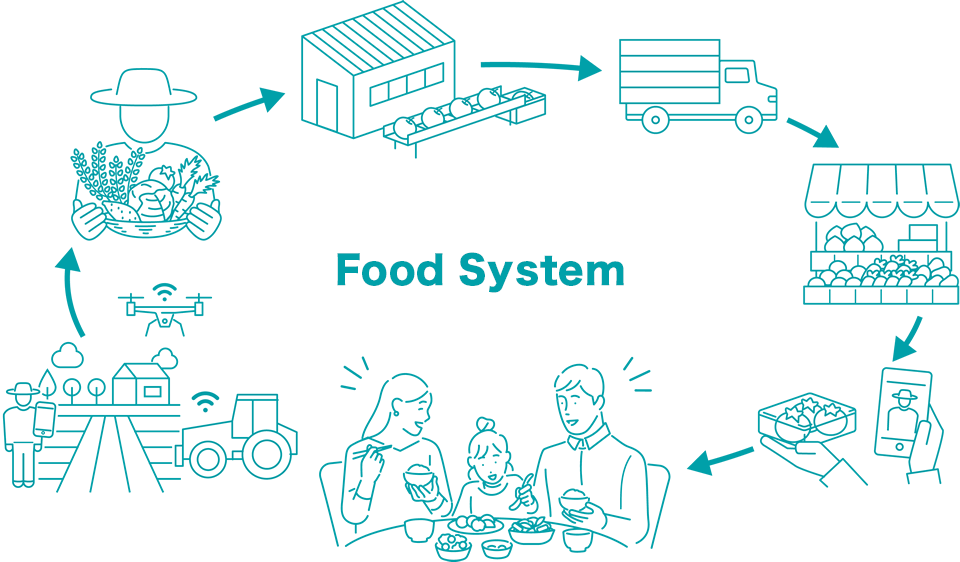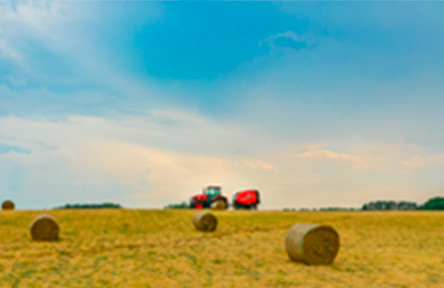The Food Systems and Kubota's Perspective
The world's food and agriculture sectors are currently facing numerous challenges, bringing attention to the term “Food System.” This page introduces the meaning and purpose of the Food System, as well as Kubota's perspective on it.
What is the Food System?
The “Food System” refers to the interconnected stages spanning from the production and sale of agricultural materials to crop cultivation, processing, distribution, retail, and consumption.
The food we eat daily is not just the product of farmers who grow crops; Many people contribute to the process, including those who supply agricultural materials and energy, those who process crops, those involved in food distribution and retail, and those who prepare and serve meals, all the way until we see it on our dinner table. This entire chain from production to consumption is known as the Food System.
Why is the Food System Gaining Attention?
Recently, the term “Food System” has been appearing more frequently in various media. What is driving this increased attention?
Global Food and Agriculture Challenges
Currently, the world’s food and agriculture sectors face a range of challenges.
1. Growing food demand due to global population increase
With the world’s population continuing to grow, food demand is expected to rise further. Accordingly, it is crucial to create a society that ensures everyone has access to, nutritious, sufficient, and safe food, and to construct a system that maintains such access.
2. Sustainability in food consumption
Sustainability is needed not only in food production but also in food consumption. Expanding sustainable consumption through methods such as reducing food loss and promoting local consumption of locally produced food, encouraging balanced and nutritious diets, and enhancing food education to drive awareness and behavioral change are all necessary.
3. Aging agricultural workforce and labor shortages
The global agricultural workforce, estimated at around 1 billion people in 2000, declined by approximately 100 million by 2019*1. In Japan, the average age of farmers is about 68 years old*2. The number of commercial farming households also fell from 2.3 million in 2000 to 1.02 million in 2020*3.
- *1Food and Agriculture Organization of the United Nations (FAO) “STATISTICAL POCKET BOOK”
- *2Ministry of Agriculture, Forestry and Fisheries of Japan “Statistics on Agricultural Labor Force”
- *3Ministry of Agriculture, Forestry and Fisheries of Japan “Statistics on Agricultural Management Entities”
4. Reducing agriculture’s environmental impact
Agriculture accounts for about 24% of global greenhouse gas (GHG) emissions*4. The environmental impact of agriculture is significant, necessitating measures such as reducing chemical fertilizer and pesticide use, decarbonizing farm machinery, and promoting organic farming.
- *4National Agriculture and Food Research Organization “Development and dissemination of technologies to mitigate greenhouse gas emissions with enhanced agricultural productivity”
5. Food supply chain vulnerabilities exposed by COVID-19 and international conflicts
The COVID-19 pandemic and unstable international conditions due to conflicts, etc., have disrupted food supply chains, preventing even produced food from reaching those who need it. Strengthening global food supply chains has become increasingly critical.
As described above, the issues facing food and agriculture are diverse. To solve them, it is essential to take a comprehensive view of the entire Food Systems.
Why is it Necessary to Take a Comprehensive View of the Entire Food Systems?
Simply increasing agricultural production does not guarantee that food will reach those who need it in the necessary quantities. Enhancing only certain stages of the Food Systems will not be enough to solve the challenges facing food and agriculture.
To address these challenges, it is crucial to view not only the individual stage in the Food Systems but also the entire process–from production to consumption–as a single, interconnected flow, optimizing every stage while maintaining overall balance. Additionally, since the Food Systems now extend globally, solutions must be considered not just within individual countries or regions, but on a worldwide scale.
Benefits of Optimizing the Entire Food Systems
By optimizing the Food Systems as a whole, benefits can be realized for people in various roles, as well as for society and the global environment.
| Consumers |
|
|---|---|
| Distributors |
|
| Producers |
|
| Society |
|
| Global Environment |
|
Kubota’s Approach to Supporting the Entire Food Systems
Building a sustainable food system is an important theme for Kubota, who is engaged in the business fields of food, water, and the environment, and whose mission is to contribute to solving social issues. In its long-term vision, “GMB2030,” announced in 2021, Kubota set the goal of becoming an "Essentials Innovator for Supporting Life" committed to a prosperous society and cycle of nature. Kubota is actively promoting the provision of solutions that support the entire Food Systems.
For example, in the “production” area of agriculture, which is one of Kubota’s existing business sectors, the company is promoting smart agriculture by leveraging advanced technologies such as robotics, ICT, and AI, contributing to the drastic reduction of labor and improvement of productivity in agriculture. Furthermore, Kubota is expanding its solution offerings from “production” to both upstream and downstream, building a data integration platform across the entire Food Systems, and contributing to the realization of sustainable Food Systems and the reduction of food loss.
These initiatives are driven by Kubota, which has long led the development of automated agricultual machines and precision farming systems, applying its technologies, solutions, achievements, and experience gained over many years of addressing agricultural challenges. At the same time, Kubota believes that open innovation is essential to accelerate efforts in solving global challenges. The company is strengthening collaborations with external partners such as startups, universities, and research institutions, working with stakeholders to co-create value and develop solutions that contribute to solving global food and agricultural issues.





